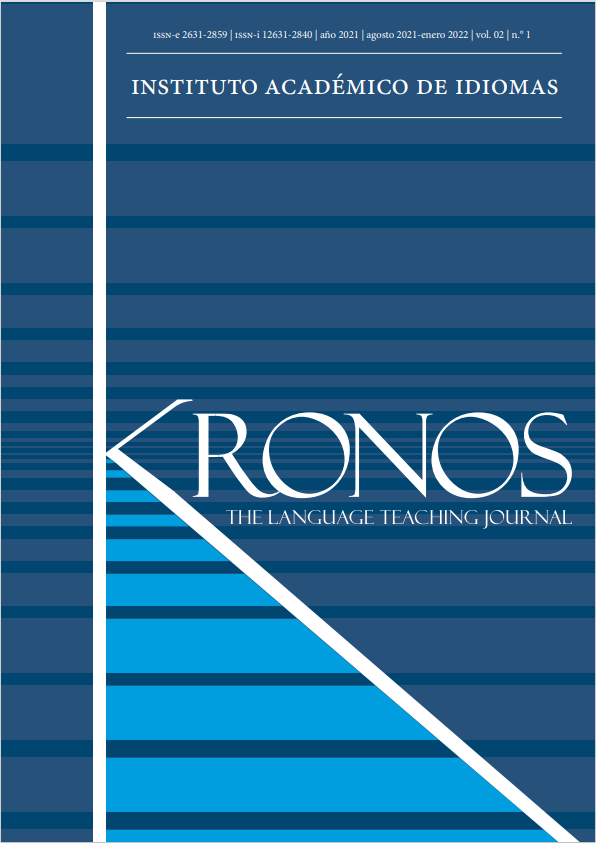Errores comunes de entonación de la producción del idioma inglés como lengua extranjera (EFL) en estudiantes adultos de nivel intermedio-bajo
DOI:
https://doi.org/10.29166/kronos.v2i1.3111Palabras clave:
Entonación, Praat, ascenso y descenso tonal, contornos tonales, características suprasegmentalesResumen
Este proyecto investiga la entonación en preguntas y pedidos en 10 alumnos que aprenden inglés en un país cuyo idioma es español y que tienen un nivel intermedio. El objetivo de este estudio es identificar y analizar los errores de entonación más comunes. Analizar la situación actual de entonación es importante para la propuesta de actividades metodológicas que mejoren problemas específicos de entonación. En efecto, esta investigación compara los contornos tonales de dos preguntas y dos pedidos de hablantes nativos con estudiantes. Este estudio descriptivo concluyó que: los estudiantes parecen no estar conscientes de los contornos tonales y la función que desempeñan los patrones de entonación y que el idioma nativo influye en la producción del segundo idioma. Estos resultados sugieren que herramientas tecnológicas como Praat pueden servir en el proceso de aprendizaje y enseñanza sobre entonación.
Descargas
Citas
Busà, M. G., & Stella, A. (2015). The acquisition of English L2 prosody by Italian native speakers: Experimental data and pedagogical implications. In J. Levis, R. Mohammed, M. Qian & Z. Zhou (Eds). Proceedings of the 6th Pronunciation in Second Language Learning and Teaching Conference, ISSN 2380-9566, Santa Barbara, CA (pp. 15-26). Ames, IA: Iowa State University.
Boersma & Weenink (2011). Praat: doing phonetics by computer. Viewing a spectrogram. https://www.fon.hum.uva.nl/praat/
Celce-Murcia, M., Brinton, D. M., & Goodwin, J. M. (1996). Teaching pronunciation: A reference for teachers of English to speakers of other languages. Cambridge University Press.
Cruttenden, A. (1981). Falls and rises: meanings and universals. Journal of Linguistics, 17(1), 77-91.
Collins, B., & Mees, I. M. (2013). Practical phonetics and phonology: A resource book for students. Routledge.
De Bot, K., & Mailfert, K. (1982). The teaching of intonation: Fundamental research and classroom applications. Tesol Quarterly, 16(1), 71-77.
Derwing, T. M. (2008). Curriculum issues in teaching pronunciation to second language learners. Phonology and second language acquisition, 36, 347-369.
Farías, M. G. V. (2013). A comparative analysis of intonation between Spanish and English speakers in tag questions, wh-questions, inverted questions, and repetition questions. Revista Brasileira de Linguística Aplicada, 13(4), 1061-1083.
McCrocklin, S. (2015). Automatic speech recognition: Making it work for your pronunciation class. In J. Levis, R. Mohammed, M. Qian & Z. Zhou (Eds). Proceedings of the 6th Pronunciation in Second Language Learning and Teaching Conference (ISSN 2380-9566), Santa Barbara, CA (pp. 126-133). Ames, IA: Iowa State University.
Nikolić, D. (2018). Empirical analysis of intonation activities in EFL student’s books. International Journal of Applied Linguistics and English Literature, 7(3), 181-187.
Richards, J. (2013). Interchange fifth Edition. United Kingdom: Cambridge University Press.
Roach, P. (2009). English phonetics and phonology paperback with audio CDs (2): A practical course. Cambridge University Press.
Krashen, S. (2013). Second language acquisition: Theory, applications, and some conjectures. Mexico City: Cambridge University.
Zhang, Y., & Liu, L. (2018). Using computer speech recognition technology to evaluate spoken English. Educational Sciences: Theory & Practice, 18(5).
Descargas
Publicado
Cómo citar
Número
Sección
Licencia
Derechos de autor 2021 Diana Vaca Barragán

Esta obra está bajo una licencia internacional Creative Commons Atribución-NoComercial-CompartirIgual 4.0.












